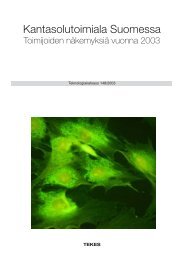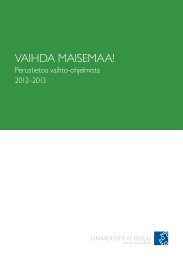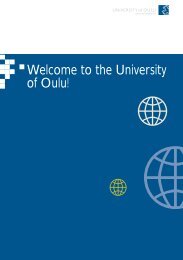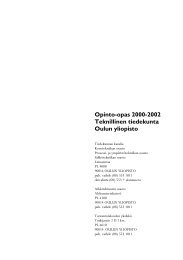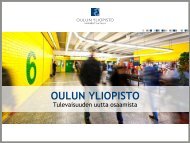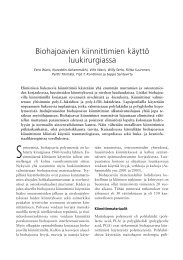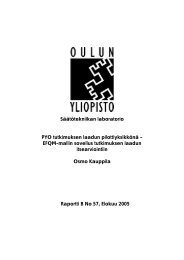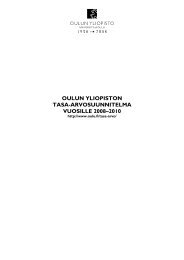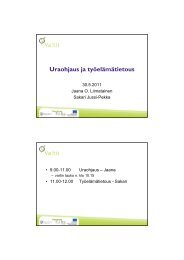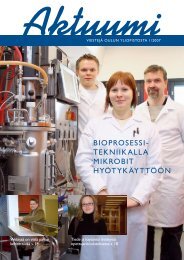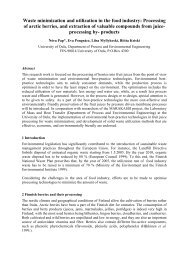A Study of Microcontrollers in Finnish Comprehensive Schools - Oulu
A Study of Microcontrollers in Finnish Comprehensive Schools - Oulu
A Study of Microcontrollers in Finnish Comprehensive Schools - Oulu
Create successful ePaper yourself
Turn your PDF publications into a flip-book with our unique Google optimized e-Paper software.
Journal <strong>of</strong> Technology Education Vol. 18 No. 2, Spr<strong>in</strong>g 2007<br />
Children as Innovators <strong>in</strong> Action – A <strong>Study</strong> <strong>of</strong><br />
<strong>Microcontrollers</strong> <strong>in</strong> F<strong>in</strong>nish <strong>Comprehensive</strong> <strong>Schools</strong><br />
Esa-Matti Järv<strong>in</strong>en, Arto Karsikas, and Jouni H<strong>in</strong>tikka<br />
In authoritative teach<strong>in</strong>g methods, whereby the teacher controls the social<br />
<strong>in</strong>teraction and other classroom activities, the actions <strong>of</strong> many children are <strong>of</strong>ten<br />
<strong>in</strong> response to what they perceive to be the teacher's expectations and the<br />
requirements <strong>of</strong> traditional school evaluation practices, such as exam<strong>in</strong>ations<br />
and tests (Edwards & Mercer, 1987; Vygotsky, 1997, p. 126). In this k<strong>in</strong>d <strong>of</strong><br />
school sett<strong>in</strong>g, children do not necessarily feel the teach<strong>in</strong>g and its content to be<br />
personally important or useful. For this reason, it is difficult for them to make<br />
mean<strong>in</strong>gful connections between what they are taught and their everyday life.<br />
To make learn<strong>in</strong>g more authentic and mean<strong>in</strong>gful to children, it is essential to<br />
give them a sense <strong>of</strong> ownership for their learn<strong>in</strong>g (Savery & Duffy, 1995). As<br />
epitomized by Biesta (1994, p. 315), it is important that the “contribution <strong>of</strong> the<br />
child is not a pseudo-contribution that is totally dependent upon the <strong>in</strong>tentions<br />
and activities <strong>of</strong> the teacher.” In this regard also, von Glasersfeld (1995, p.14)<br />
wrote aptly “[p]roblems are not solved by the retrieval <strong>of</strong> rote-learned ‘right’<br />
answers. To solve a problem <strong>in</strong>telligently, one must first see it as one’s own<br />
problem.” Moreover, it is important that children be able to work <strong>in</strong> an<br />
atmosphere which is low <strong>in</strong> stress and allows concentration on the task at hand<br />
(Futschek, 1995).<br />
S<strong>in</strong>ce technology can be seen as a response to “satisfy human needs and<br />
wants” (Black & Harrison, 1985; Dugger & Yung, 1995; Savage & Sterry,<br />
1990) and as human <strong>in</strong>novation <strong>in</strong> action (see ITEA, 2000), teach<strong>in</strong>g methods <strong>in</strong><br />
technology lessons should be adjusted accord<strong>in</strong>gly. Problem solv<strong>in</strong>g is also<br />
considered essential <strong>in</strong> a technological process (e.g., McCormick, Murphy,<br />
Hennessy, and Davidson, 1996).<br />
In technology lessons the problems to be solved should relate to children’s<br />
real life environment, allow<strong>in</strong>g them to make appropriate and mean<strong>in</strong>gful<br />
connections (Schwarz, 1996). Children should be given opportunities to explore<br />
and pursue their own needs and <strong>in</strong>terests. They should be encouraged to identify<br />
problems and deficiencies <strong>in</strong> their everyday environment and be given<br />
opportunities to apply the technological knowledge and skills they have<br />
acquired <strong>in</strong> technology lessons and through previous problem-solv<strong>in</strong>g<br />
experiences (Adams, 1991).<br />
____________________<br />
Esa-Matti Järv<strong>in</strong>en, Arto Karsikas, and Jouni H<strong>in</strong>tikka dgfsjklfgjklsd djfgklsd fjgl dsjflgdsjf,<br />
University <strong>of</strong> <strong>Oulu</strong>, F<strong>in</strong>land.<br />
-37-
Journal <strong>of</strong> Technology Education Vol. 18 No. 2, Spr<strong>in</strong>g 2007<br />
<strong>Study</strong> Purpose<br />
The overall purpose <strong>of</strong> the study was to help children become familiar with<br />
some essential features <strong>of</strong> microcontroller technology and its possibilities <strong>in</strong><br />
various aspects <strong>of</strong> everyday life. Moreover, the study essentially aimed to<br />
encourage children to engage <strong>in</strong> <strong>in</strong>novative th<strong>in</strong>k<strong>in</strong>g <strong>in</strong> f<strong>in</strong>d<strong>in</strong>g uses for<br />
microcontrollers to meet their own needs and purposes. More specifically, the<br />
study <strong>in</strong>volved the follow<strong>in</strong>g:<br />
Teach<strong>in</strong>g about technology: Give children opportunities to learn about the<br />
human-made environment (technology).<br />
In accordance with this aim, an effort was made to enhance the children’s<br />
understand<strong>in</strong>g <strong>of</strong> the human-made environment “such as it is.” This aim is close<br />
to the goals <strong>of</strong> most school subjects, where teach<strong>in</strong>g aims to <strong>in</strong>crease<br />
understand<strong>in</strong>g about the world at large. In this respect familiarization with<br />
microcontrollers and their programm<strong>in</strong>g <strong>in</strong>troduced a very contemporary<br />
content area to technology education.<br />
Teach<strong>in</strong>g through technology: Give children opportunities to engage <strong>in</strong> the<br />
processes <strong>of</strong> technology, i.e., to design, make, and apply technology <strong>in</strong> a<br />
creative and <strong>in</strong>novative manner<br />
This aim could also be exemplified <strong>in</strong> the def<strong>in</strong>ition: “Technology is human<br />
<strong>in</strong>novation <strong>in</strong> action” (ITEA, 2000). If the “message” <strong>of</strong> this def<strong>in</strong>ition is the<br />
basis for teach<strong>in</strong>g technology, it cannot merely <strong>in</strong>volve the study and<br />
consideration <strong>of</strong> the functional pr<strong>in</strong>ciples <strong>of</strong> microcontroller technology as an<br />
end <strong>in</strong> itself. Children need to be given opportunities for creative and <strong>in</strong>novative<br />
action as well. This is why the study aimed to focus on the <strong>in</strong>novative uses <strong>of</strong><br />
microcontrollers <strong>in</strong> applications that arose from the pupils’ own needs and ideas.<br />
Ultimately, the study was directed toward this question: What type <strong>of</strong><br />
microcontroller applications emerged <strong>in</strong> the children’s own projects?<br />
<strong>Study</strong> Methodology<br />
Instructional Context<br />
The participants consisted <strong>of</strong> both primary and secondary school teachers<br />
who had been tak<strong>in</strong>g part <strong>in</strong> the Technology Education NOW! project over a<br />
period <strong>of</strong> years. All project schools were supplied with <strong>in</strong>formation about a<br />
microcontroller called the “Picaxe” (see www.rev-ed.co.uk/picaxe) and<br />
associated activities. Over 50 teachers were contacted and given the opportunity<br />
to participate and 12 elected to do so.<br />
First, the Picaxe-08 system was <strong>in</strong>troduced to the teachers by arrang<strong>in</strong>g a<br />
two-day <strong>in</strong>-service tra<strong>in</strong><strong>in</strong>g course. The course consisted <strong>of</strong> both theoretical and<br />
practical aspects <strong>of</strong> microcontrollers with a special emphasis on the Picaxe-08<br />
system. Another focus <strong>of</strong> the tra<strong>in</strong><strong>in</strong>g was the programm<strong>in</strong>g s<strong>of</strong>tware.<br />
Importantly, the teachers were encouraged to make their own <strong>in</strong>novative Picaxe<br />
applications and this pedagogical perspective was also emphasized for the<br />
-38-
Journal <strong>of</strong> Technology Education Vol. 18 No. 2, Spr<strong>in</strong>g 2007<br />
teachers to take <strong>in</strong>to account with<strong>in</strong> the forthcom<strong>in</strong>g Picaxe project with their<br />
pupils.<br />
Second, Picaxe s<strong>of</strong>tware and hardware, <strong>in</strong>clud<strong>in</strong>g components for<br />
children’s applications, were sent to the participat<strong>in</strong>g schools. Instructions for<br />
<strong>in</strong>troduc<strong>in</strong>g the microcontroller system to the children were <strong>in</strong>cluded <strong>in</strong> the<br />
Picaxe package.<br />
The Picaxe-08 system shown <strong>in</strong> Figure 1 is a relatively new k<strong>in</strong>d <strong>of</strong> tool for<br />
apply<strong>in</strong>g microcontrollers <strong>in</strong> an educational sett<strong>in</strong>g and is based on the 8-p<strong>in</strong><br />
PIC (Peripheral Interface Computer) <strong>in</strong>tegrated circuit chip. While<br />
programm<strong>in</strong>g, children can design the functions desired by means <strong>of</strong> a flowchart<br />
or by us<strong>in</strong>g the BASIC language, after which the program is downloaded with a<br />
serial cable to the microcontroller on the project (circuit) board. To enable<br />
children’s <strong>in</strong>novativeness, a special project board was designed for the study<br />
(see Figure 1). First, the children constructed a project us<strong>in</strong>g <strong>in</strong>structions and<br />
diagrams provided (Pictures 2 and 3). However, the projects were not<br />
operational and used to familiarize the students with the materials before<br />
actually beg<strong>in</strong>n<strong>in</strong>g the design acitivity (Pictures 4-19). In the end, the idea was<br />
that the children could design, make, and program an application ris<strong>in</strong>g from<br />
their own ideas and needs. To enhance th<strong>in</strong>k<strong>in</strong>g <strong>of</strong> different possible<br />
applications, a wide variety <strong>of</strong> components were sent to the schools. These<br />
<strong>in</strong>cluded light emitt<strong>in</strong>g diodes (LEDs), buzzers, lamps, motors, sound record<strong>in</strong>g<br />
modules, m<strong>in</strong>iature water pumps, as well as sensors such as various k<strong>in</strong>ds <strong>of</strong><br />
switches, passive <strong>in</strong>frared sensors (PIRs) as well as negative temperature<br />
coefficient (NTC hereafter) thermistors and light dependent resistors (LDRs).<br />
The s<strong>of</strong>tware is available free <strong>of</strong> charge from the manufacturer and most <strong>of</strong> it<br />
has been translated <strong>in</strong>to F<strong>in</strong>nish. One important feature <strong>of</strong> the Picaxe system is<br />
that children can reprogram the device repeatedly, design<strong>in</strong>g new and improved<br />
applications to their lik<strong>in</strong>g.<br />
Figure 1. The flowchart s<strong>of</strong>tware and project board used <strong>in</strong> the study<br />
-39-
Journal <strong>of</strong> Technology Education Vol. 18 No. 2, Spr<strong>in</strong>g 2007<br />
Figure 2. The project board be<strong>in</strong>g assembled<br />
(right).<br />
(left) and be<strong>in</strong>g tested<br />
<strong>Study</strong> Participants<br />
Twelve comprehensive (primary and secondary) school classes <strong>of</strong> grades 5-<br />
8 (ages 11-14 years) participated <strong>in</strong> the study. The number <strong>of</strong> children <strong>in</strong>volved<br />
was 230. The participat<strong>in</strong>g schools were located <strong>in</strong> <strong>Oulu</strong> Prov<strong>in</strong>ce: Järvikylä<br />
School <strong>in</strong> Nivala, Oksava and Mart<strong>in</strong>mäki <strong>Schools</strong> <strong>in</strong> Haapajärvi, Vattukylä,<br />
Hyttikallio and Karhukangas <strong>Schools</strong> <strong>in</strong> Haapavesi, Ruukki School <strong>in</strong> Ruukki,<br />
Kestilä Central School <strong>in</strong> Kestilä, Matkaniva and Petäjäskoski <strong>Schools</strong> <strong>in</strong><br />
Oula<strong>in</strong>en, L<strong>in</strong>tulampi School <strong>in</strong> <strong>Oulu</strong> and Kärsämäki Central School <strong>in</strong><br />
Kärsämäki. All the participat<strong>in</strong>g schools were state schools, which is the<br />
predom<strong>in</strong>ant comprehensive school system <strong>in</strong> F<strong>in</strong>land.<br />
Data collection<br />
True to the qualitative data collection methods, multiple data sources and<br />
strategies were employed, apply<strong>in</strong>g the concept <strong>of</strong> triangulation (Miles &<br />
Hubermann, 1994: 266). Data were collected <strong>in</strong> the follow<strong>in</strong>g ways: Pictures<br />
taken <strong>of</strong> the children work<strong>in</strong>g while mak<strong>in</strong>g the Picaxe applications, teacher’s<br />
written reports, researcher’s notes <strong>of</strong> the process and applications, children’s<br />
written and drawn sketches <strong>of</strong> their applications, photographs and video clips <strong>of</strong><br />
the children’s f<strong>in</strong>al outcomes, as well as <strong>in</strong>terviews <strong>of</strong> children documented on<br />
video record<strong>in</strong>gs. The <strong>in</strong>terviews were carried out <strong>in</strong> authentic situations where<br />
children expla<strong>in</strong>ed their applications. The questions asked from the children<br />
emerged spontaneously from the situation. Thus, the <strong>in</strong>terviews were not prestructured<br />
and, consequently, there was no “standard” time that they lasted<br />
either. Moreover, not every child was <strong>in</strong>terviewed. Some <strong>of</strong> the children’s<br />
applications called for more explanation than others. For example if the teacher<br />
told the researchers that not all the essential <strong>in</strong>formation <strong>of</strong> the child’s<br />
application were to be found <strong>in</strong> the sketches, draw<strong>in</strong>gs, etc., an <strong>in</strong>terview session<br />
was arranged to deepen the understand<strong>in</strong>g <strong>of</strong> what the child had actually done<br />
and accomplished.<br />
-40-
Journal <strong>of</strong> Technology Education Vol. 18 No. 2, Spr<strong>in</strong>g 2007<br />
Data Analysis<br />
Dur<strong>in</strong>g the first round <strong>of</strong> analysis, the researchers began to form an idea <strong>of</strong><br />
the emergent categories relative to the theme <strong>of</strong> this study. In subsequent<br />
analysis rounds the data revealed more organized patterns relative to the<br />
research question. Dur<strong>in</strong>g the analysis process, the researchers were cont<strong>in</strong>ually<br />
open to re-explor<strong>in</strong>g the relationship between the data and emergent f<strong>in</strong>d<strong>in</strong>gs<br />
and mak<strong>in</strong>g revisions correspond<strong>in</strong>gly. They discussed and shared thoughts on<br />
several occasions. The data examples presented <strong>in</strong> this article were considered<br />
<strong>in</strong>dividually and also <strong>in</strong> the collaborative discussions (see Ritchie & Hampson,<br />
1996). F<strong>in</strong>ally, the researchers reached the stage where they considered to have<br />
<strong>in</strong>vestigated the entire body <strong>of</strong> data sufficiently relative to the research<br />
problems. Once the researchers reached the “saturation po<strong>in</strong>t” with the data,<br />
efforts were redirected to presentation <strong>of</strong> the results and related analysis.<br />
Results<br />
The categories presented <strong>in</strong> the Table 1 are the result <strong>of</strong> go<strong>in</strong>g through the<br />
data several times and search<strong>in</strong>g for emerg<strong>in</strong>g patterns. The categories <strong>in</strong>dicate<br />
that the systems the children designed and built with the Picaxe were rather<br />
varied. Even with<strong>in</strong> one classroom there was a rather large variation <strong>in</strong> what<br />
children made for their Picaxe application (except <strong>in</strong> the case <strong>of</strong> Amusement<br />
Park Devices, Hydro-Copters and Race Cars). This is an <strong>in</strong>terest<strong>in</strong>g<br />
phenomenon <strong>in</strong> itself, for children tended to be rather <strong>in</strong>dependent <strong>in</strong> pursu<strong>in</strong>g<br />
their own idea.<br />
Table 1<br />
Categories and examples emerg<strong>in</strong>g from the data<br />
Categories and Examples<br />
Models <strong>of</strong><br />
Exist<strong>in</strong>g<br />
Devices Everyday Needs Competition<br />
Amusement park<br />
devices<br />
Traffic lights<br />
Hydrocopters<br />
Low light sensor<br />
Burglar alarm<br />
systems<br />
Presents for<br />
mother<br />
Name plates<br />
us<strong>in</strong>g LEDs<br />
Sound record<strong>in</strong>g<br />
module<br />
Fish feed<strong>in</strong>g<br />
system<br />
Race cars<br />
Just for Fun or<br />
Decoration<br />
Joe-boy, the<br />
speak<strong>in</strong>g parrot<br />
Founta<strong>in</strong><br />
Music<br />
applications<br />
Map <strong>of</strong> F<strong>in</strong>land<br />
with LEDs<br />
Logo <strong>of</strong> the icehockey<br />
team<br />
with LEDs<br />
Small<br />
bushes/trees with<br />
LEDs<br />
-41-
Journal <strong>of</strong> Technology Education Vol. 18 No. 2, Spr<strong>in</strong>g 2007<br />
Sun Sp<strong>in</strong><br />
Sketch <strong>of</strong> Sun Sp<strong>in</strong><br />
Dim Light Sensor<br />
Ferris Wheel <strong>in</strong> the Mak<strong>in</strong>g<br />
HydroCopter<br />
Figure 3. Examples <strong>of</strong> modell<strong>in</strong>g exist<strong>in</strong>g devices (1)<br />
-42-
Journal <strong>of</strong> Technology Education Vol. 18 No. 2, Spr<strong>in</strong>g 2007<br />
Amusement Park<br />
Figure 4. Examples <strong>of</strong> modell<strong>in</strong>g exist<strong>in</strong>g devices (2)<br />
Model<strong>in</strong>g Exist<strong>in</strong>g Devices<br />
Some students modeled exist<strong>in</strong>g devices. For example, most <strong>of</strong> the<br />
amusement park devices shown <strong>in</strong> Figures 3 and 4 are what would be found <strong>in</strong><br />
actual amusement parks. The children have seen them while visit<strong>in</strong>g the parks<br />
and modeled the devices accord<strong>in</strong>gly. The other applications, like traffic lights<br />
and hydro-copters, <strong>in</strong>volved the same idea <strong>of</strong> model<strong>in</strong>g someth<strong>in</strong>g that already<br />
exists. Even though the dim-light sensor shown <strong>in</strong> Figure 3 has the obvious idea<br />
<strong>of</strong> practical need, it can be regarded more as a model <strong>of</strong> the exist<strong>in</strong>g device, for<br />
it was not meant to be used as a “real th<strong>in</strong>g.”<br />
There was also an <strong>in</strong>novative bias <strong>in</strong> some <strong>of</strong> the applications <strong>in</strong> this<br />
category. For example, design<strong>in</strong>g the light control system for hydro-copters, and<br />
figur<strong>in</strong>g out how to make it function properly <strong>in</strong>spired children to be problemsensitive<br />
and even <strong>in</strong>novative. But, the overall process started with the<br />
will<strong>in</strong>gness to make m<strong>in</strong>iature models <strong>of</strong> exist<strong>in</strong>g devices. Thus, do<strong>in</strong>g<br />
someth<strong>in</strong>g which would be a response to emergent needs and purposes was not<br />
a primary motive.<br />
-43-
Journal <strong>of</strong> Technology Education Vol. 18 No. 2, Spr<strong>in</strong>g 2007<br />
Programm<strong>in</strong>g an LED Flower<br />
Presents for Mothers’ Day<br />
Mak<strong>in</strong>g a Burglar Alarm<br />
Figure 5. Examples <strong>of</strong> projects designed to meet everyday needs.<br />
Excerpts from Video Clips<br />
Excerpt 1 – In reference to Burglar Alarm <strong>in</strong> Figure 5.<br />
Researcher:<br />
Could you tell me how came up with that idea?<br />
Child:<br />
We came up with this idea…because some unidentified visitors had<br />
visited our hut <strong>in</strong> the woods….and the teachers told us that we’ll do<br />
these th<strong>in</strong>gs [microcontroller systems] I got an idea that I can make a<br />
k<strong>in</strong>d <strong>of</strong> alarm system….and actually it has served the need pretty<br />
well…<br />
Researcher:<br />
Could you tell me how it works?<br />
Child:<br />
[show<strong>in</strong>g the alarm system to the researcher] here is the on/<strong>of</strong>f<br />
switch....and here is a sound record<strong>in</strong>g module on which you can<br />
record whatever you want to say….and when the system is activated<br />
…and when it [passive <strong>in</strong>frared sensor] identifies somebody<br />
mov<strong>in</strong>g…the system switches on the [LED] eyes and plays the<br />
recorded message, “unauthorized access denied!”<br />
-44-
Journal <strong>of</strong> Technology Education Vol. 18 No. 2, Spr<strong>in</strong>g 2007<br />
Excerpt 2- In reference to Sound Record<strong>in</strong>g Module<br />
Teacher:<br />
OK, could you tell me what that is?<br />
Child:<br />
If I’m not at home….somebody can leave a message on it [Sound<br />
record<strong>in</strong>g module] by push<strong>in</strong>g a button and when I come home I can<br />
listen to the message.<br />
Teacher:<br />
Yes… that is useful.<br />
This category <strong>in</strong>cludes more <strong>in</strong>novative applications which tend to be<br />
responses to needs and purposes identified by the children. It was essential<br />
among these ideas that the children wanted to solve a practical problem aris<strong>in</strong>g<br />
from their personal liv<strong>in</strong>g environment such as the burglar alarm system<br />
illustrated <strong>in</strong> Figure 5 or a fish feed<strong>in</strong>g system. Importantly, the applications<br />
were tested <strong>in</strong> the actual situation <strong>in</strong> which they were <strong>in</strong>tended to be used. If the<br />
application, such as the burglar alarm system, did not function properly it was<br />
modified and tested aga<strong>in</strong>.<br />
Although there already are many burglar alarm systems <strong>in</strong> the environment<br />
<strong>in</strong> which the children live, they did not copy these exist<strong>in</strong>g systems. Instead they<br />
connected components <strong>in</strong>to the applications supply<strong>in</strong>g their own needs, as was<br />
the case <strong>in</strong> “Unauthorized access denied!” In Excerpt 1 the child (12 year old 6 th<br />
grader) expla<strong>in</strong>ed both the problem which ‘ignited’ the technological process<br />
and the pr<strong>in</strong>ciple upon which the system operated. In Excerpt 2 the response <strong>of</strong><br />
the child (12 years old 6 th grader) reveals the start<strong>in</strong>g po<strong>in</strong>t for the process <strong>of</strong><br />
perform<strong>in</strong>g the application with the Picaxe. It is analogous to a modern version<br />
<strong>of</strong> writ<strong>in</strong>g a quick message on a paper. Though the on-site <strong>in</strong>terviews<br />
exemplified by the two excerpts above were not conducted with most students,<br />
they did provide some details that would not have otherwise been known.<br />
Presents for mother are made every year <strong>in</strong> F<strong>in</strong>nish schools, but the Picaxe<br />
project and associated materials took the students <strong>in</strong> a different direction from<br />
the greet<strong>in</strong>g cards typical <strong>of</strong> the past. Some <strong>of</strong> these new ideas are shown <strong>in</strong><br />
Figure 5. Importantly, the process started by do<strong>in</strong>g someth<strong>in</strong>g that would<br />
actually operate <strong>in</strong> response to the needs and purposes identified by the children<br />
themselves. This <strong>in</strong> itself is an important notion and makes creat<strong>in</strong>g the<br />
technological application real for the student <strong>in</strong>stead <strong>of</strong> contrived as many<br />
school projects can end up be<strong>in</strong>g. It is a technological solution that they created<br />
even though the hardware and s<strong>of</strong>tware they used already was <strong>in</strong> use <strong>in</strong> “the<br />
adults’ world.” (Savery & Duffy, 1995)<br />
Competitions<br />
Despite concerns to the contrary, competitions do seem to be very useful <strong>in</strong><br />
teach<strong>in</strong>g technology. When compet<strong>in</strong>g with each other, children tend to be very<br />
motivated and focused <strong>in</strong> problem-solv<strong>in</strong>g. For example, if they do not have the<br />
fastest race car, they are motivated to see how they can make it perform better.<br />
-45-
Journal <strong>of</strong> Technology Education Vol. 18 No. 2, Spr<strong>in</strong>g 2007<br />
Race cars model elements <strong>in</strong> the real world. However, children are not<br />
limited <strong>in</strong> their th<strong>in</strong>k<strong>in</strong>g to duplicat<strong>in</strong>g what already exists. For example, some<br />
children supply motive power us<strong>in</strong>g propellers <strong>in</strong>stead <strong>of</strong> us<strong>in</strong>g the traditional<br />
idea <strong>of</strong> supply power to wheels. See Figure 6. The creativity <strong>of</strong> the student can<br />
be enhanced and expanded by how the problem is stated. For example, if the<br />
problem is to build the “fastest device” <strong>in</strong>stead <strong>of</strong> the “fastest car,” children tend<br />
to th<strong>in</strong>k differently.<br />
F<strong>in</strong>ish<strong>in</strong>g touches be<strong>in</strong>g added to<br />
race car<br />
Program download<strong>in</strong>g to microcontroller<br />
chip<br />
Figure 6. Projects designed for competition<br />
The last category that evolved <strong>in</strong>cluded projects that were “just for fun” or<br />
served decorative purposes. The applications <strong>in</strong> this category are shown <strong>in</strong><br />
Figure 7. They did not directly correspond to the children’s needs and purposes<br />
emerg<strong>in</strong>g from their own liv<strong>in</strong>g environment. At the same time the researchers<br />
recognized the need for children to have beautiful and fun th<strong>in</strong>gs <strong>in</strong> their<br />
environment. In that sense, the projects met the needs <strong>of</strong> the children. For<br />
example, the map <strong>of</strong> F<strong>in</strong>land with certa<strong>in</strong> cities highlighted with LEDs has some<br />
practical value, but this was not substantiated <strong>in</strong> either the teacher’s report or <strong>in</strong><br />
other data sources. Moreover, the applications <strong>in</strong> this category were not<br />
<strong>in</strong>tended to just model someth<strong>in</strong>g already exist<strong>in</strong>g. When hav<strong>in</strong>g fun, children<br />
may <strong>in</strong>vent a new, different and even <strong>in</strong>novative use for technology as well. Joe<br />
Boy – The Speak<strong>in</strong>g Parrot (see Figure 7) was awarded third place <strong>in</strong> a national<br />
research and <strong>in</strong>vention competition for children <strong>in</strong> May 2005<br />
-46-
Journal <strong>of</strong> Technology Education Vol. 18 No. 2, Spr<strong>in</strong>g 2007<br />
Proud creators <strong>of</strong> Joe Boy<br />
Joe Boy, the talk<strong>in</strong>g parrot<br />
Water founta<strong>in</strong><br />
LED map <strong>of</strong> F<strong>in</strong>land<br />
Figure 7. Projects designed for fun alone<br />
Discussion<br />
The Picaxe teach<strong>in</strong>g experiment was not really designed pedagogically to<br />
teach students how microcontrollers work, as would typically be the case <strong>in</strong> the<br />
upper grades. Instead, the emphasis was on help<strong>in</strong>g students realize their own<br />
ideas and needs by apply<strong>in</strong>g microcontroller technology <strong>in</strong> a creative and<br />
<strong>in</strong>novative manner. Moreover, the Picaxe teach<strong>in</strong>g was not directed by<br />
traditional school evaluation practices. Even the teacher did not necessarily<br />
know what k<strong>in</strong>d <strong>of</strong> applications the children would eventually create. One <strong>of</strong> the<br />
teachers wrote, “For the first time, there was an electronics project whose f<strong>in</strong>al<br />
product was not known by anyone at the start <strong>of</strong> the project. When they were<br />
putt<strong>in</strong>g the project board together, the pupils acquired <strong>in</strong>formation and skills on<br />
-47-
Journal <strong>of</strong> Technology Education Vol. 18 No. 2, Spr<strong>in</strong>g 2007<br />
basic issues <strong>in</strong> electronics (components, solder<strong>in</strong>g, etc.), but at the same time<br />
they were constantly th<strong>in</strong>k<strong>in</strong>g about the subsequent application and its various<br />
possible uses”. In spite <strong>of</strong> the openness <strong>of</strong> the Picaxe activity, some children had<br />
a tendency to copy and mimic the ideas <strong>of</strong> other children. This raises the<br />
question <strong>of</strong> what is appropriate <strong>in</strong> the support and encouragement <strong>of</strong> children to<br />
“trust” their own needs and ideas and to take the risk to pursue them. Such risk<br />
tak<strong>in</strong>g is not <strong>of</strong>ten rewarded <strong>in</strong> traditional school situations. The worry <strong>of</strong><br />
failure, negatively re<strong>in</strong>forced by prior experiences <strong>in</strong> school, may have cause<br />
some students to copy ideas from others. At the same time, it does not mean that<br />
every student should be expected to be an <strong>in</strong>novator. The important th<strong>in</strong>g is that<br />
each student be able to pursue ideas that meet their personal needs, and those<br />
needs might be satisfied from copy<strong>in</strong>g a project idea from another student.<br />
This study confirmed once aga<strong>in</strong> that children have very fertile m<strong>in</strong>ds for<br />
com<strong>in</strong>g up with unique ideas. Educators and other adults must make every effort<br />
to consider the ideas <strong>of</strong> children seriously and with encouragement. One never<br />
knows when the ideas <strong>of</strong> children could lead to new k<strong>in</strong>ds <strong>of</strong> applications and<br />
<strong>in</strong>novations. Ultimately, every effort should be made to assure that a child’s<br />
experience with technology education positive, builds confidence, and results <strong>in</strong><br />
directly experienc<strong>in</strong>g “human <strong>in</strong>novation <strong>in</strong> action” (ITEA, 2000). The study<br />
also re<strong>in</strong>forced the notion that technological understand<strong>in</strong>g and problem-solv<strong>in</strong>g<br />
ability is a unique k<strong>in</strong>d <strong>of</strong> human <strong>in</strong>telligence (Chen, 1996).<br />
Innovation is not just someth<strong>in</strong>g carried out <strong>in</strong> the research and<br />
development laboratories <strong>of</strong> large technology <strong>in</strong>dustries, but all <strong>of</strong> us, <strong>in</strong>clud<strong>in</strong>g<br />
children, can be <strong>in</strong>novators. As a result <strong>of</strong> the ongo<strong>in</strong>g research, the authors<br />
repeatedly reaffirm that one <strong>of</strong> the most serious pitfalls <strong>of</strong> technology education<br />
is to underestimate the ability <strong>of</strong> children to be creative and <strong>in</strong>novative <strong>in</strong><br />
technology. As Barlex & Pitt (2000, p.12) stated, “be<strong>in</strong>g ‘technological’ is part<br />
<strong>of</strong> what makes us human.”<br />
The possibility to change the human-made world empowers children <strong>in</strong> a<br />
way not usually experienced <strong>in</strong> schoolwork. Interest<strong>in</strong>gly, this echoes Piaget’s<br />
thoughts <strong>of</strong> the pr<strong>in</strong>cipal purpose <strong>of</strong> education be<strong>in</strong>g to encourage children to do<br />
new th<strong>in</strong>gs and not just repeat<strong>in</strong>g what previous generations have done – to<br />
<strong>in</strong>spire them to be creative, <strong>in</strong>ventive and discoverers (Piaget, 1970).<br />
Conclusion<br />
In technology education it is important to engender the idea <strong>of</strong> how the<br />
human-made environment has developed and is still develop<strong>in</strong>g through human<br />
activity. Ingenuity, <strong>in</strong>novation, and problem solv<strong>in</strong>g are part <strong>of</strong> the basic essence<br />
<strong>of</strong> technology (e.g. Sparkes, 1993; Järv<strong>in</strong>en & Hiltunen, 2000; Järv<strong>in</strong>en, 2001).<br />
Consequently, <strong>in</strong> technology lessons it is essential to also enable children to<br />
have ownership <strong>of</strong> their design<strong>in</strong>g and mak<strong>in</strong>g processes. The researchers<br />
observed that many <strong>of</strong> the children who took part <strong>in</strong> the study acted <strong>in</strong><br />
accordance with the idea put forward by Adams (1991):<br />
Successful <strong>in</strong>ventors that I know are extremely problem-sensitive. They are<br />
tuned to the little <strong>in</strong>conveniences or hardships <strong>in</strong> life that can be addressed by<br />
the technology they know. (p. 87)<br />
-48-
Journal <strong>of</strong> Technology Education Vol. 18 No. 2, Spr<strong>in</strong>g 2007<br />
If a child is able to identify a problem and proves to be successful <strong>in</strong><br />
solv<strong>in</strong>g it <strong>in</strong> a way that the solution meets personal needs, it results <strong>in</strong> a very<br />
positive experience. It is “serious bus<strong>in</strong>ess” to the child and importantly, <strong>in</strong> the<br />
process he/she goes through the processes truly reflective <strong>of</strong> technology<br />
(Layton, 1993).<br />
It is natural and, <strong>in</strong> some cases imperative, to provide technology education<br />
through an <strong>in</strong>tegrative approach that cuts across subject boundaries. The<br />
“Human and Technology” theme <strong>in</strong> the new F<strong>in</strong>nish curriculum framework is an<br />
example. Technology is multidiscipl<strong>in</strong>ary by nature and cannot be limited only<br />
to applied science or handicraft skills.<br />
In technology lessons, the do<strong>in</strong>g and its understand<strong>in</strong>g are most important.<br />
Teach<strong>in</strong>g technology should not beg<strong>in</strong> with the <strong>in</strong>troduction <strong>of</strong> conceptual<br />
jargon, but with design challenges that enable children to come across the<br />
underly<strong>in</strong>g technological pr<strong>in</strong>ciples spontaneously while engaged <strong>in</strong> the learn<strong>in</strong>g<br />
activity (Papert, 1980).<br />
The authors advocate that children's understand<strong>in</strong>g <strong>of</strong> technology can be<br />
achieved by enabl<strong>in</strong>g them to work <strong>in</strong> the same spirit that real technologists do.<br />
This approach br<strong>in</strong>gs authenticity to the experience. It is also essential that<br />
children are encouraged to work and learn <strong>in</strong> a way that fosters creativity and<br />
discovery. This can be facilitated <strong>in</strong> an atmosphere that is low <strong>in</strong> stress and<br />
enable children to concentrate on their own problems (Futschek, 1995).<br />
In clos<strong>in</strong>g, the authors wish to encourage teachers who are not already<br />
do<strong>in</strong>g so to try an open-ended approach to technology teach<strong>in</strong>g. More work and<br />
preparation is required, along with open-m<strong>in</strong>dedness and the courage to deviate<br />
from the normal school rout<strong>in</strong>es, but the rewards are worth the effort. When the<br />
f<strong>in</strong>al outcome <strong>of</strong> children’s problem solv<strong>in</strong>g processes is unknown to them,<br />
boredom and dis<strong>in</strong>terest is replaced with thrill<strong>in</strong>g anticipation (Järv<strong>in</strong>en &<br />
Hiltunen, 2000).<br />
References<br />
Adams, J.L. (1991). Fly<strong>in</strong>g buttresses, entropy, and O-r<strong>in</strong>gs. The world <strong>of</strong> an<br />
eng<strong>in</strong>eer. Cambridge , MA: Harvard University Press.<br />
Barlex, D. & Pitt, J. (2000). Interaction: The relationship between science and<br />
design and technology <strong>in</strong> the secondary school curriculum. London:<br />
Eng<strong>in</strong>eer<strong>in</strong>g Council.<br />
Biesta, G. (1994). Education as <strong>in</strong>tersubjectivity. Educational Theory, 44, 299-<br />
317.<br />
Black, P. & Harrison, G. (1985). In place <strong>of</strong> confusion: Technology and science<br />
<strong>in</strong> the school curriculum. Nuffield-Chelsea Curriculum Trust and the<br />
National Centre for School Technology. London: Trent Polytechnic.<br />
Chen, D. (1996). Reflections on technological th<strong>in</strong>k<strong>in</strong>g. In: D. Mioduser & I.<br />
Zilberste<strong>in</strong> (Eds.), The second Jerusalem <strong>in</strong>ternational science and<br />
technology education conference on technology education for a chang<strong>in</strong>g<br />
future:Ttheory, policy and practice (p. S3 – 5-6). Book <strong>of</strong> abstracts. Tel<br />
Aviv: Center for Educational Technology.<br />
-49-
Journal <strong>of</strong> Technology Education Vol. 18 No. 2, Spr<strong>in</strong>g 2007<br />
Dugger, W. E. Jr. & Yung, J. E. (1995). Technology education today.<br />
Bloom<strong>in</strong>gton, IL: Phi Delta Kappa Educational Foundation.<br />
Edwards, D. & Mercer, N. (1987). Common knowledge: The development <strong>of</strong><br />
understand<strong>in</strong>g <strong>in</strong> the classroom. London: Metheuen.<br />
Erickson, F. (1986). Qualitative methods <strong>in</strong> research on teach<strong>in</strong>g. In: M.C.<br />
Wittrock (Ed.), Handbook <strong>of</strong> research on teach<strong>in</strong>g; Third Edition (p. 119-<br />
161). New York, NY: Macmillan.<br />
Futschek, G. (1995). Start<strong>in</strong>g learn<strong>in</strong>g with computer controlled models. In<br />
T<strong>in</strong>sley, J. D. & van Weert, T. J. (Eds.), Proceed<strong>in</strong>gs <strong>of</strong> the 6th World<br />
Conference on Computers <strong>in</strong> Education. Birm<strong>in</strong>gham, UK: Chapman &<br />
Hall.<br />
Honebe<strong>in</strong> P. C., Duffy T. M., & Fishman B. J. (1993). Constructivism and the<br />
design <strong>of</strong> learn<strong>in</strong>g environments: Context and authentic activities for<br />
learn<strong>in</strong>g. In T. M. Duffy, J. Lowyck, & D. H. Jonassen (Eds.), Design<strong>in</strong>g<br />
environments for constructive learn<strong>in</strong>g. Berl<strong>in</strong>: Spr<strong>in</strong>ger-Verlag.<br />
International Technology Education Association (2000). Standards for<br />
technological literacy: Content for the study <strong>of</strong> technology. Author: Reston,<br />
VA<br />
Järv<strong>in</strong>en, E-M. (2001). Education about and through technology. In search <strong>of</strong><br />
more appropriate pedagogical approaches to technology education. Acta<br />
Universitatis <strong>Oulu</strong>ensis: Scientiae Rerum Socialium E50. <strong>Oulu</strong>, F<strong>in</strong>land:<br />
<strong>Oulu</strong> University Press. (http://herkules.oulu.fi/isbn9514264878/)<br />
Järv<strong>in</strong>en, E-M. & Hiltunen, J. (2000). Automation technology <strong>in</strong> elementary<br />
technology education. Journal <strong>of</strong> Industrial Teacher Education. 37(4).<br />
Layton, D. (1993). Technology’s challenge to science education. Buck<strong>in</strong>gham,<br />
England: Open University Press.<br />
McCormick, R.; Murphy, P.; Hennessy, S.; & Davidson, M. (1996). Research<br />
on student learn<strong>in</strong>g <strong>of</strong> design<strong>in</strong>g and problem solv<strong>in</strong>g <strong>in</strong> technology activity<br />
<strong>in</strong> schools <strong>in</strong> England. Paper presented to the American Research<br />
Association Annual Meet<strong>in</strong>g, New York, April, 1996.<br />
Miles, M. B. & Huberman, A. M. (1994). Qualitative data analysis. Thousand<br />
Oaks, CA: Sage Publications.<br />
Papert, S. (1980). M<strong>in</strong>dstorms: Children, computers, and powerful ideas.<br />
Brighton, England: Harvester.<br />
Patton, M.Q. (1990). Qualitative evaluation and research methods. Newbury<br />
Park, CA: Sage Publications.<br />
Piaget, J. (1970). Science <strong>of</strong> education and the psychology <strong>of</strong> the child. New<br />
York: Orion.<br />
Ritchie, S.M & Hampson, B. (1996). Learn<strong>in</strong>g <strong>in</strong> the mak<strong>in</strong>g: A case study <strong>of</strong><br />
science and technology projects <strong>in</strong> a year six classroom. Research <strong>in</strong><br />
Science Education, 26(4), 391-407.<br />
Savage, E. & Sterry, L. (1990). A conceptual framework for technology<br />
education. Reston, VA: International Technology Education Association.<br />
-50-
Journal <strong>of</strong> Technology Education Vol. 18 No. 2, Spr<strong>in</strong>g 2007<br />
Savery, J. R. & Duffy, T. M. (1995). Problem based learn<strong>in</strong>g: an <strong>in</strong>structional<br />
model and its constructivist framework. Educational Technology, 35, 31-<br />
38.<br />
Schwartz, A. (1996). Pr<strong>in</strong>ciples <strong>of</strong> logic- A learn<strong>in</strong>g module for the<br />
understand<strong>in</strong>g and implementation <strong>of</strong> logic at the junior high school level.<br />
In Mioduser, D. & Zilberste<strong>in</strong>, I. (Eds.), The second Jerusalem<br />
<strong>in</strong>ternational science and technology education conference on technology<br />
education for a chang<strong>in</strong>g future: Theory, policy and practice. Book <strong>of</strong><br />
abstracts. Tel Aviv: Center for Educational Technology.<br />
Sparkes, J. (1993). Some differences between science and technology. In R.<br />
McCormick, C. Newey, & J. Sparkes (Eds.), Technology for technology<br />
education. London: Addison-Wesley Publish<strong>in</strong>g Company.<br />
von Glasersfeld, E. (1995). A constructivist approach to teach<strong>in</strong>g. In: P.L.<br />
Steffe. & J. Gale (Eds), Constructivism <strong>in</strong> education (p. 3-15). Hillsdale,<br />
NJ: Lawrence Erlbaum Associates.<br />
Vygotsky, L.S. (1997). Educational psychology. Boca Raton, FL: St. Lucie<br />
Press<br />
-51-



